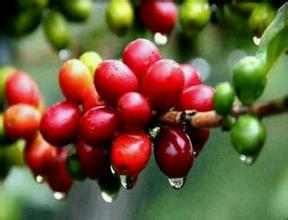Introduction of Flower Butterfly Coffee Bean Taste Grinding scale Manor Flavor description processing method
Introduction of Flower Butterfly Coffee Bean Taste Grinding scale Manor Flavor description processing method
On the basis of very excellent quality, the very people-friendly price makes this coffee bean cost-effective. What is special about this coffee bean is that it is made up of three varieties, 40% of which is the famous rose summer, giving this coffee a distinct rose summer flavor. According to the information obtained from the raw bean merchant, due to the historical reasons of the manor, in order to pursue yield at that time, the early rose summer varieties were mixed with the coffee trees of Kaddura and Kaduai, and in order to facilitate picking, coffee farmers did not reclassify them, but directly mixed the three varieties. After that, as Rosa rose to fame and the price soared, the processing plant began to carry out fine washing treatment for such a coffee bean.
[time-limited free delivery] the most cost-effective coffee bean in history, Panama Pokuit Flower Butterfly 40% Rose Summer
There are many ways of washing, but generally speaking, the floating beans are removed after the coffee fruit is picked, then the pulp is removed, and then the coffee beans are soaked in a fermentation trough. The enzymes in the water will soften the mucus attached to the peel of the coffee beans. Natural yeast will break down the sugar in the mucus, a process called fermentation. After the fermentation is completed, move the coffee beans to the sun field to dry. In the process of drying, you need to constantly turn the coffee beans to ensure the uniformity of the drying. Finally, the shell is kept in a cool warehouse, and some raw bean merchants place an order before shelling and bagging. The processed coffee tastes clean, emphasizing bright and lively acidity, as well as clear fruit flavor and floral aroma.
Because of the particularity of this butterfly in the variety, we use medium and shallow baking to complete the final flavor trend of this bean, so that it not only has the unique floral aroma and bergamot flavor of Rosa, but also has the outstanding flavor of cherry, Nanyang fruit and berry fruit, and has the sweetness and smoothness of honey, the aroma and tail rhyme are very long-lasting, and the taste is quite amazing.
But I think it is quite extravagant to drink rose summer every day, and even if there is no financial pressure, it is not like eating shark's fin and bear's paw every day. The same is true of coffee. Only by dabbling in a wide range of people can we enjoy the pleasure of tasting coffee. There are also many excellent estates in the Pokuit producing area, except the famous Emerald Manor, Alida Manor, Aqaba Manor and so on. All produce high-quality boutique coffee. This is not only due to the superior ecological conditions of the Pokuit region of Panama and the fertile volcanic ash soil of the Baru volcanic land. Another important factor is that the microclimate in the Poquet Heights of Panama is a unique and important resource for boutique coffee in the Pokuit region. This is the Panamanian environment from east to west, which allows the cold air to converge over 6500 feet through the Central Mountains, thus creating a variety of microclimates in the Pokuit region, making its temperature and rainfall very suitable for plant growth. so the coffee trees grown here are in good condition.
There are many ways of washing, but generally speaking, the floating beans are removed after the coffee fruit is picked, then the pulp is removed, and then the coffee beans are soaked in a fermentation trough. The enzymes in the water will soften the mucus attached to the peel of the coffee beans. Natural yeast will break down the sugar in the mucus, a process called fermentation. After the fermentation is completed, move the coffee beans to the sun field to dry. In the process of drying, you need to constantly turn the coffee beans to ensure the uniformity of the drying. Finally, the shell is kept in the warehouse, and some raw bean merchants place an order before shelling and bagging. The processed coffee tastes clean, emphasizing bright and lively acidity, as well as clear fruit flavor and floral aroma.

Important Notice :
前街咖啡 FrontStreet Coffee has moved to new addredd:
FrontStreet Coffee Address: 315,Donghua East Road,GuangZhou
Tel:020 38364473
- Prev

Introduction of Panamanian Flower Butterfly Coffee Bean Variety Grinding scale Manor
The Panamanian Flower Butterfly Coffee Bean Variety Grinding scale Manor introduces the particularity of the flower butterfly in the breed. We use medium-light baking to complete the final flavor trend of this bean, so that it not only has the unique flavor of rose summer, bergamot flavor, cherry, Nanyang fruit, berry fruit flavor is also outstanding, and has the sweetness and smoothness of honey, aroma and
- Next

G1 Manning Coffee Bean Flavor description Grinding scale treatment manor taste introduction
G1 manning coffee bean flavor description grinding scale treatment manor taste introduction while Sumatra manning is a rare Arabica species. These trees are planted on hillsides between 750m and 1500 meters above sea level, mysterious and unique Sumatra, giving Mantenin coffee, rich aroma, rich taste, strong flavor. Make it unique, with a hint of chocolate and
Related
- Detailed explanation of Jadeite planting Land in Panamanian Jadeite Manor introduction to the grading system of Jadeite competitive bidding, Red bid, Green bid and Rose Summer
- Story of Coffee planting in Brenka region of Costa Rica Stonehenge Manor anaerobic heavy honey treatment of flavor mouth
- What's on the barrel of Blue Mountain Coffee beans?
- Can American coffee also pull flowers? How to use hot American style to pull out a good-looking pattern?
- Can you make a cold extract with coffee beans? What is the right proportion for cold-extracted coffee formula?
- Indonesian PWN Gold Mandrine Coffee Origin Features Flavor How to Chong? Mandolin coffee is American.
- A brief introduction to the flavor characteristics of Brazilian yellow bourbon coffee beans
- What is the effect of different water quality on the flavor of cold-extracted coffee? What kind of water is best for brewing coffee?
- Why do you think of Rose Summer whenever you mention Panamanian coffee?
- Introduction to the characteristics of authentic blue mountain coffee bean producing areas? What is the CIB Coffee Authority in Jamaica?

